The commencement of a new easing cycle by the Federal Reserve is positively impacting the precious metals sector, leading to notable increases in the prices of gold, silver, and platinum group metals (PGMs).
While gold remains the focal point of investor interest, platinum is beginning to draw attention as its prices have surged past $1,000 per ounce, marking the highest level seen in ten weeks. Recent trading showed September platinum futures at $1,013.20 per ounce, reflecting a 2% increase during the session.
Market analysts attribute the attractiveness of precious metals to several factors, including declining interest rates, decreasing real yields, and a weakening U.S. dollar. Additionally, the World Platinum Investment Council (WPIC) highlights another significant factor: the increasing long-term deficits in platinum supply.
In a recent discussion with Kitco News, Edward Sterck, Director of Research at the WPIC, emphasized that the growing deficit in the platinum market is expected to exert upward pressure on prices. This statement coincides with the WPIC’s release of its demand trends report for the second quarter.
According to the WPIC, platinum is projected to experience a deficit of one million ounces this year, although Sterck indicated this is merely a segment of a broader trend. He stated, “We expect that underlying fundamentals should offer some support for prices. We are confident that there will be further deficits in the platinum market.”
The WPIC released updated long-term projections, forecasting an average supply deficit of approximately 769,000 ounces of platinum from 2025 to 2028, revised downward from an earlier estimate of 546,000 ounces made in January.
Analysts predict that weak supply growth coupled with robust demand will drive deficits in the coming years. The report noted a reduction in average projected platinum production in South Africa by 179,000 ounces for the 2025-2028 period, reflecting a 4% decline attributed to margin pressures that deter new production growth. Similarly, North American platinum production forecasts have been cut by 109,000 ounces, or 33%, for the same timeframe.
Despite the anticipated shift towards battery electric vehicles (BEVs) taking market share from internal combustion engines, the demand from the automotive sector is expected to remain strong. However, the WPIC cautions that projections for BEV growth may be overly optimistic.
“BEV demand growth has slowed from over 30% year-on-year in 2023 to mid-single-digit growth in 2024 year-to-date,” the WPIC noted. This slowdown in growth is primarily due to consumer hesitance regarding full battery electrification, challenges related to reducing BEV prices, delays in public charging infrastructure rollout, and diminishing government subsidies.
Additionally, increasing demand for hybrid electric vehicles, which utilize catalytic converters to mitigate harmful emissions, is likely to support platinum prices. The automotive sector accounts for 80% of platinum demand.
The WPIC also identifies a rising trend in investment demand, with projections indicating a net annual increase of 128,000 ounces, largely due to the inclusion of demand for Chinese bars and coins.
As the market’s deficits expand, analysts anticipate a continued depletion of above-ground platinum stocks. “Platinum’s relatively inelastic demand will necessitate drawing down above-ground stocks to meet multi-year market deficits from 2025 to 2028. It remains uncertain what price point will be necessary to attract the required portion of these stocks to address the supply shortfall,” they remarked.
In conclusion, the combination of resilient demand, supply-side risks, and diminishing stockpiles presents a compelling investment case for platinum in the near future.
You Might Be Interested In
- Silver Prices Steady Near $32 as Fed Speculation Grows
- Financial Markets Face Volatility Amid Economic Uncertainty and Liquidity Growth
- U.S. Housing Market Shows Stabilization Amid Declining Sales,gold close to the $2,700 per ounce mark


